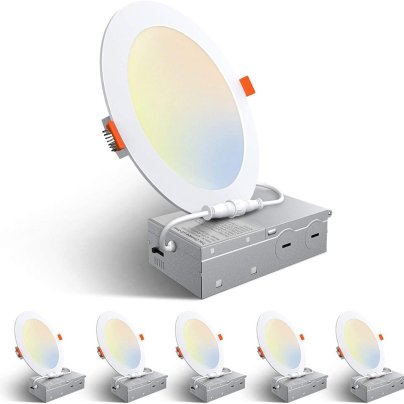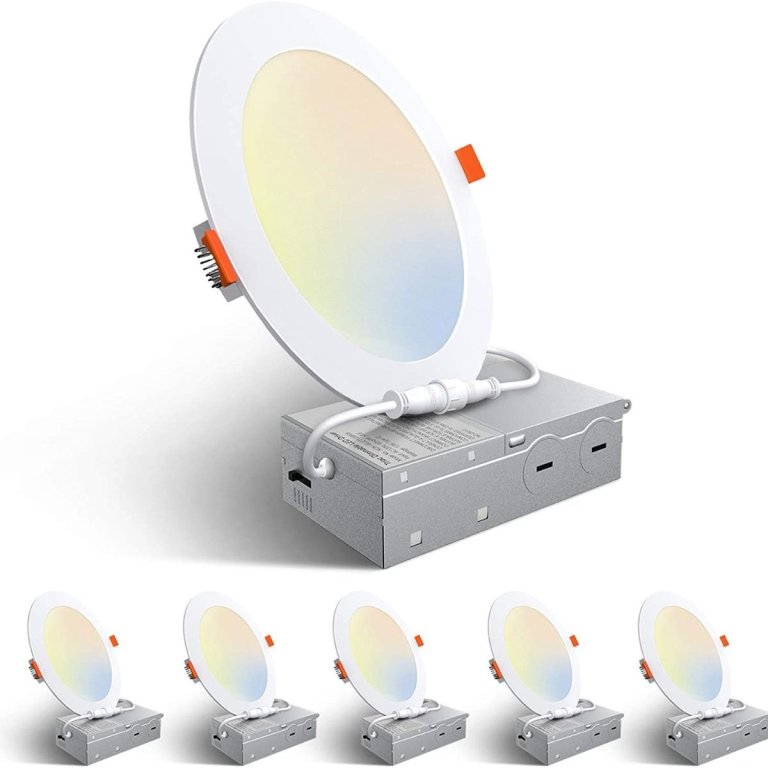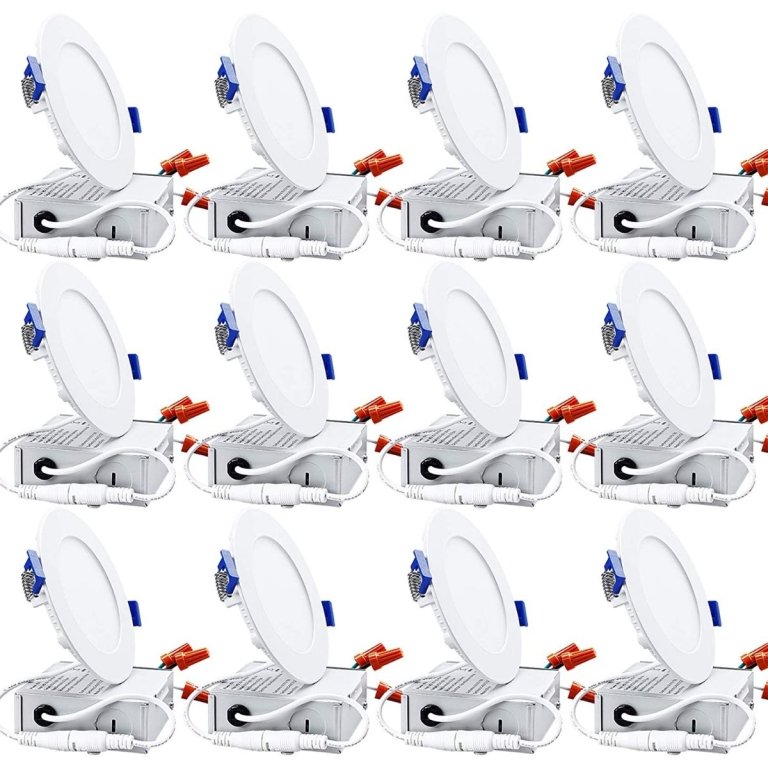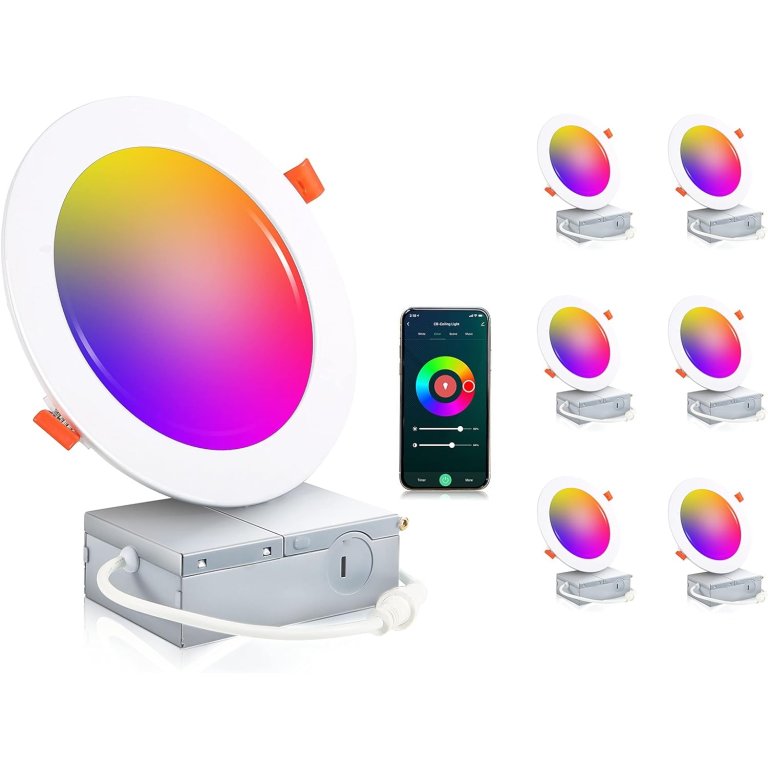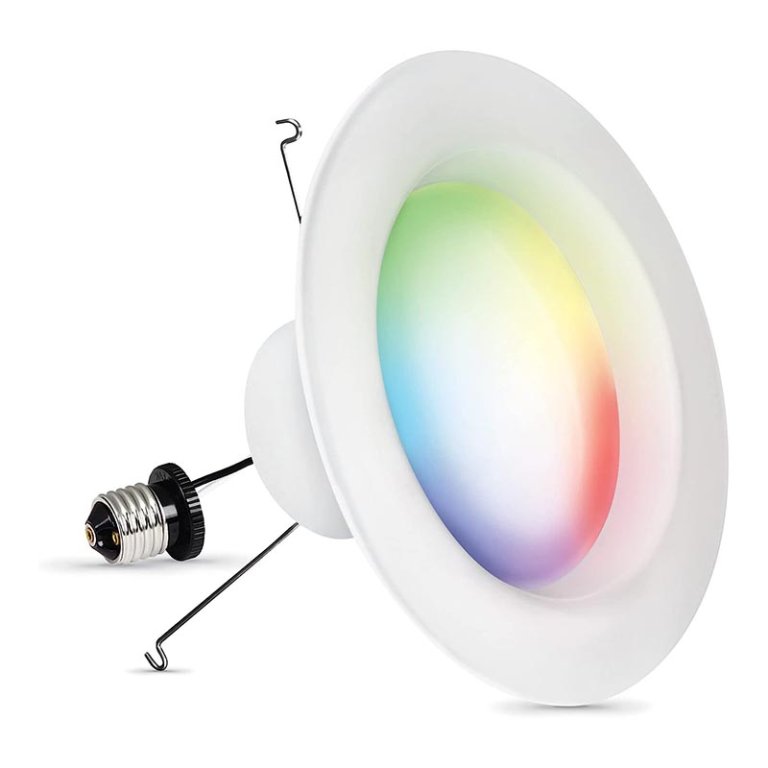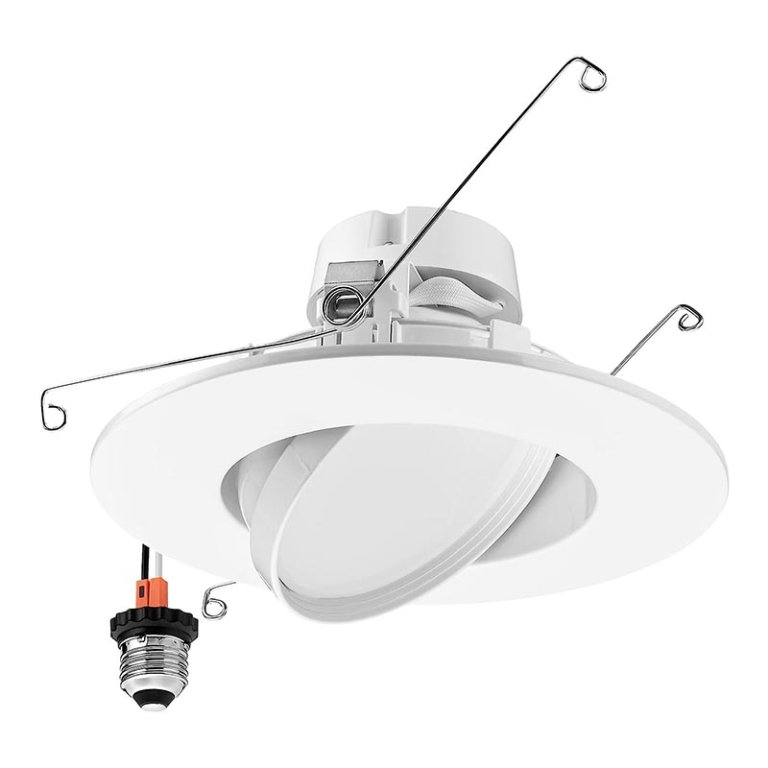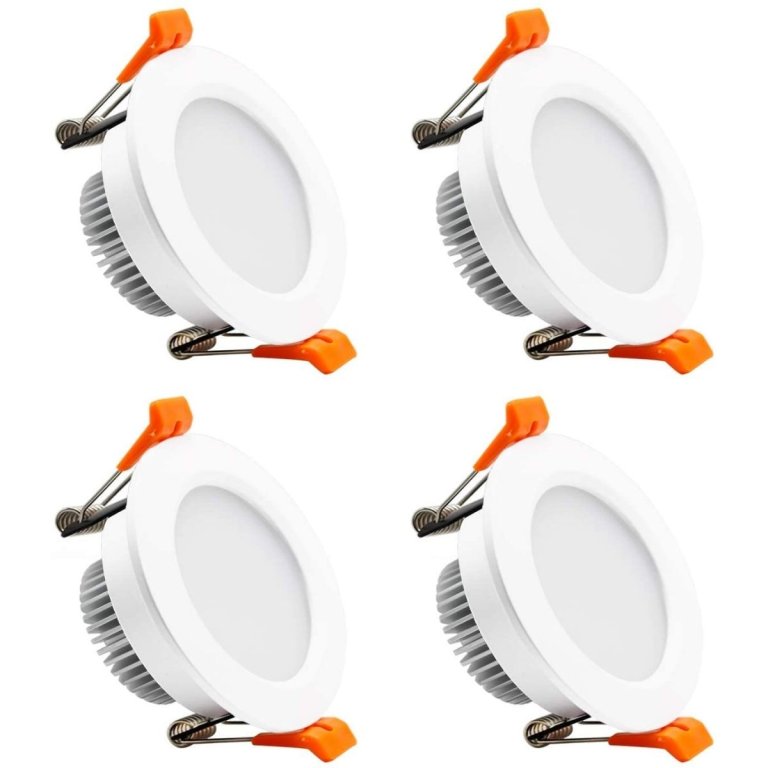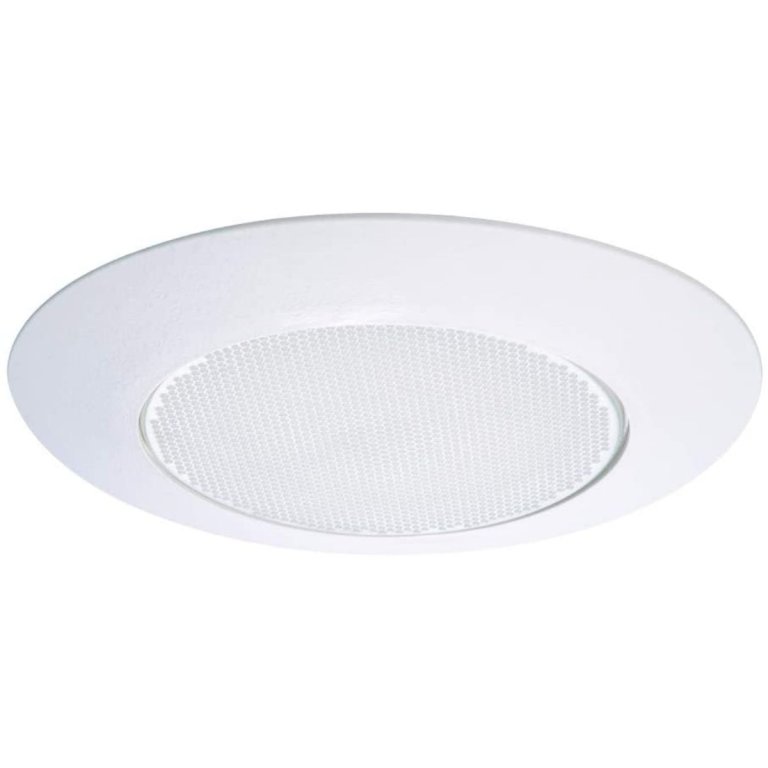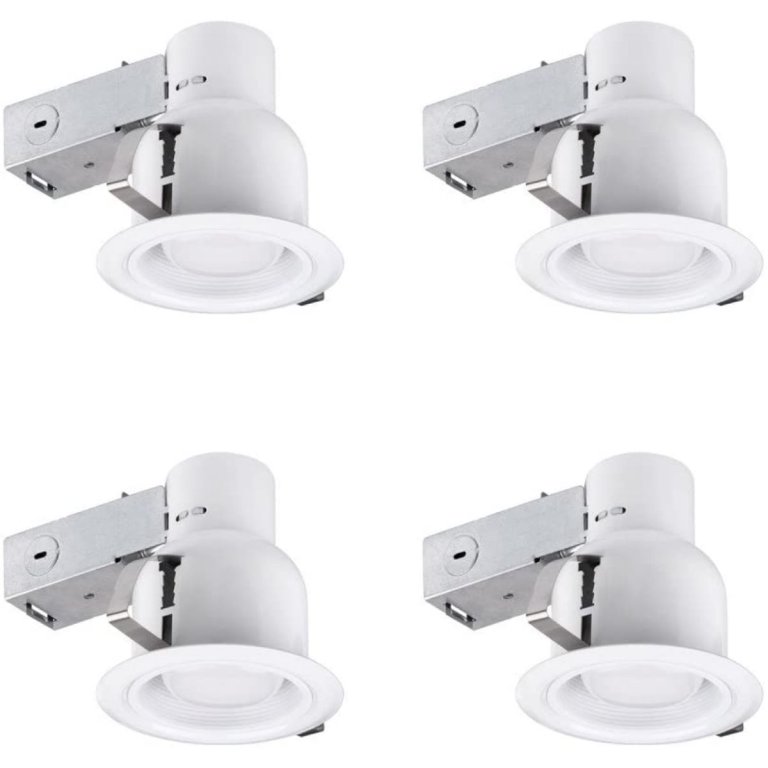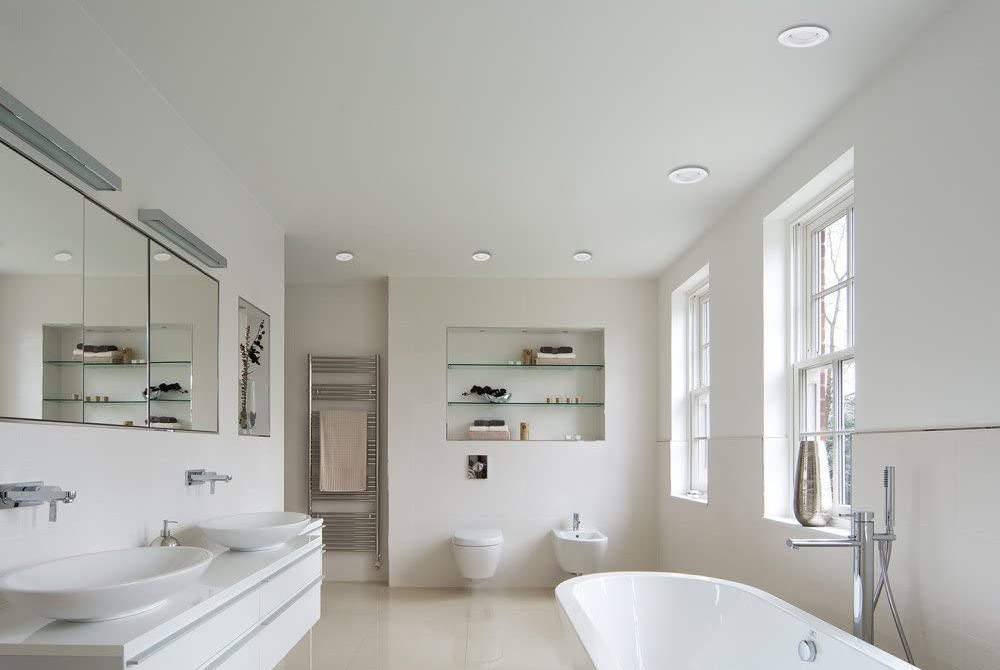
We may earn revenue from the products available on this page and participate in affiliate programs. Learn More ›
Chandeliers, under-cabinet lighting, and ceiling fans all have their place in lighting a home, but to add additional illumination discreetly, consider recessed lighting. Recessed lighting fixtures have a bulb contained inside an inverted cylindrical recessed fixture that’s mounted virtually flush with the ceiling. This means recessed lighting takes up physical space without competing with your room’s decor.
The best recessed lighting will depend on your preference for allover or directional lighting as well as the room’s purpose. Brayden Montgomery, owner of Vantage Builders, a general contracting company based in West Haven, Utah, recommends LED light fixtures: “They provide quality light for up to 25 years while saving over 80 percent in energy costs compared to incandescents.” He adds that in homes, he often installs 4-inch LED recessed lights at 6,000 to 8,000 lumens for living spaces.
Our top choice is Amico’s ultra-thin LED recessed lighting, with its multiple color temperature options in a budget-friendly 6-pack. Ahead, learn more ins and outs of recessed lighting, and find out why the following products are considered to be the best recessed lighting in their respective categories.
- BEST OVERALL: Amico 6-Inch Ultra-Thin LED Recessed Lighting
↓ Jump to Review - BEST BANG FOR THE BUCK: Torchstar 4-Inch Basic Series LED Recessed Lights
↓ Jump to Review - BEST SMART: Cloudy Bay Smart Wi-Fi LED Recessed Lights
↓ Jump to Review - BEST DIMMABLE: Feit Electric 6-Inch Smart Recessed Downlight
↓ Jump to Review - BEST ADJUSTABLE: Maxxima 6-Inch Rotatable LED Downlight
↓ Jump to Review - BEST MINI: YGS-Tech 2-Inch LED Recessed Dimmable Downlight
↓ Jump to Review - BEST FOR SHOWER/BATHROOM: Halo 6-Inch Recessed Light
↓ Jump to Review - BEST FOR OUTDOORS: Globe Electric Rustproof Indoor/Outdoor Lighting Kit
↓ Jump to Review
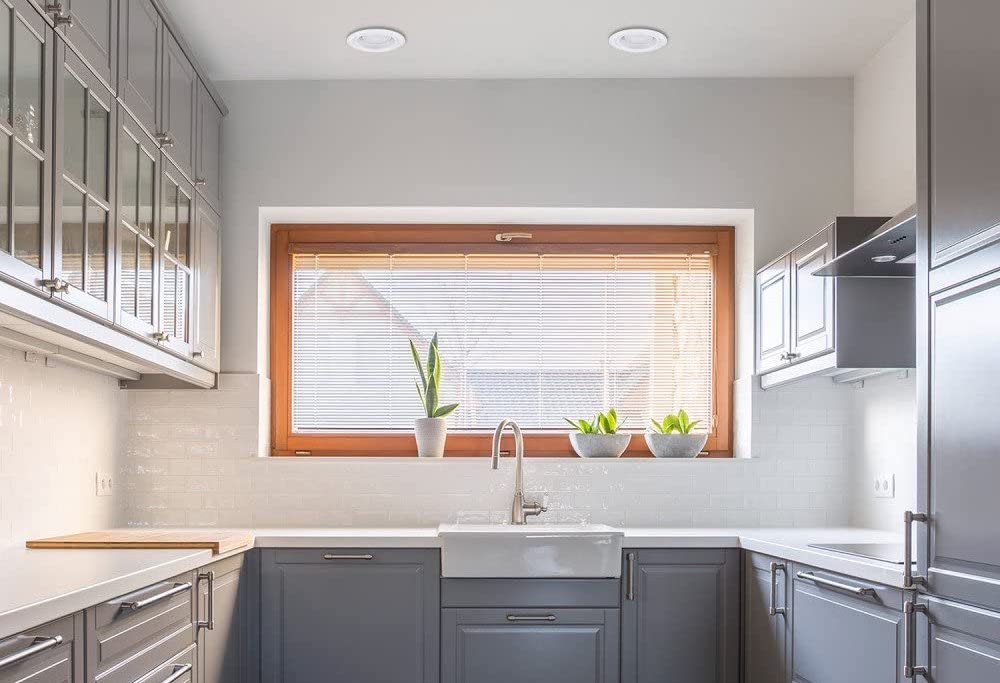
Product Comparison
| Color Temperature | Wattage | Units per pack | |
| Amico 6-Inch Ultra-Thin LED Recessed Lighting | 2700 kelvins (K), 3000K, 3500K, 4000K, and 5000K | 12 watts | 6 |
| Torchstar 4-Inch Basic Series LED Recessed Lights | 2700K, 3000K, 4000K, or 5000K | 10 watts | 12 |
| Cloudy Bay Smart Wi-Fi LED Recessed Lights | 2700K through 6500K | 15 watts | 6 |
| Feit Electric 6-Inch Smart Recessed Downlight | 2700K to 6500K, plus RBGW | 11.1 watts | 1 |
| Maxxima 6-Inch Rotatable LED Downlight | 2700K, 3000K, 3500K, 4000K, and 5000K | 11 watts | 1 |
| YGS-Tech 2-Inch LED Recessed Dimmable Downlight | 2700K, 3000K, 4000K, or 5000K | 3 watts | 4 |
| Halo 6-Inch Recessed Light | Depends on the A19 bulb you purchase (sold separately) | 60 watts | 1 |
| Globe Electric Rustproof Indoor/Outdoor Lighting Kit | Depends on the bulb you purchase (sold separately) | 50 watts | 4 |
Our Top Picks
To qualify as a top pick, a ceiling recessed light must be durable, attractive, and offer adequate illumination to meet everyday needs. The following recessed lights (many of which are sold in sets) are suitable for various uses, and one or more are likely to be a bright addition to any home.
Best Overall
Amico 6-Inch Ultra-Thin LED Recessed Lighting
What We Like
- 110 watts of light for ample brightness
- Adjustable color temperature
- Thin construction remains flush with ceiling
- Stays hidden if installed under cabinets
- Spring clamps included for quick and easy installation
What We Don’t Like
- May require professional help for proper installation
Product Specs
- Color temperature: 2700 kelvins (K), 3000K, 3500K, 4000K, and 5000K
- Wattage: 12 watts
- Units per pack: 6
Get the equivalent of 110 watts of halogen brightness with the Amico recessed ceiling lights. Each light uses only 12 watts of electricity, and six lights will illuminate small to large rooms efficiently.
These thin 6-inch lights (less than 0.5 inches thick) will fit in ceilings with clearances as shallow as 2 inches above the drywall. Users can adjust the color warmth on each light, from warm white (2700K) to cool white (5000K), to create just the right atmosphere in the room.
Each of the LED recessed lights comes with an easy-to-wire junction box, requiring users simply to match the color of the Romex wire to the corresponding slot and push the wire into the box to lock it into place. These 6-inch lights are secured in the ceiling via spring clamps. Although these recessed lights are considered DIY-friendly, those not familiar with wiring principles will want to hire an electrician to install them.
Get the Amico recessed lighting at Amazon.
Best Bang for the Buck
Torchstar 4-Inch Basic Series LED Recessed Lights
What We Like
- 80-watt illumination for ample brightness
- Suitable for living rooms, kitchens, offices, and more
- Comes with a dimming feature
- Aluminum shell keeps unit cool to the touch
- Spring clips included for easy mounting
- Affordable compared to similar options on the market
What We Don’t Like
- Heavyweight construction; may be tricky when installing
Product Specs
- Color temperature: 2700K, 3000K, 4000K, or 5000K
- Wattage: 10 watts
- Units per pack: 12
To reap the benefits of LED can lights and stay on budget, consider Torchstar’s dimmable recessed lighting. Each of the 4-inch lights uses only 10 watts of electricity but provides brightness equivalent to an 80-watt incandescent bulb for ample illumination. The thin housing installs to ceiling drywall using spring clips, and each light features an easy-to-wire junction box that doesn’t require attachment to ceiling joists.
Similar to other LED light bulbs, the Torchstar recessed lights remain cool to the touch due to the built-in aluminum shell, so they won’t get hot in the ceiling. The lights are compatible with most wall-mounted dimmer switches, allowing users to decrease brightness to suit their mood and conserve even more energy.
Get the Torchstar recessed lighting at Amazon.
Best Smart
Cloudy Bay Smart Wi-Fi LED Recessed Lights
What We Like
- Offers more than 16 million colors
- Lighting color can change with music beats or hand claps
- Voice control; compatible with Amazon Alexa and Google Home Assistant
- Comes with 8 preprogrammed “scenes”
What We Don’t Like
- Connectivity can be spotty
Product Specs
- Color temperature: 2700K through 6500K
- Wattage: 15 watts
- Units per pack: 6
If you’ve been searching for a smart recessed lighting option, then you’ll want to check out the Cloudy Bay recessed lights. This product offers a mind-blowing 16 million colors ranging from cool to warm white light. You can set your lighting preferences to align with different needs and activities, like reading, working, watching movies, and dining.
Compatible with both Amazon Alexa and Google Home Assistant, the Cloudy Bay recessed lights can also be synced to music—have the colors change with the beat for your next dance party. These lights also feature remote control access through a smartphone, timer and schedule options, and the ability to create lighting groups organized by room.
Get the Cloudy Bay recessed lighting at Amazon or Cloudy Bay.
Best Dimmable
Feit Electric 6-Inch Smart Recessed Downlight
What We Like
- Set brightness, color temperature, and color
- Compatible with Alexa and Google Home Assistant
- Fits most 5- or 6-inch can housings
- Standard base adapter
- Energy Star–certified model
What We Don’t Like
- Multiple units may need to be purchased
Product Specs
- Color temperature: 2700K to 6500K, plus RBGW
- Wattage: 11.1 watts
- Units per pack: 1
Dimmable, color-changing, and smart, the Feit Electric RGBW Smart recessed downlight is the perfect light to set the mood. This LED light uses only 11.1 watts to produce a bright 75-watt-equivalent light. Users can control brightness and color, and they can set schedules from a smartphone app—the light connects directly to Wi-Fi, so there’s no need for a hub.
For those with a smart-home system, this light can connect to Alexa or Google Home Assistant to enable voice controls. Each pack includes one Energy Star–certified light that fits most 5- to 6-inch recessed can housings. A standard base adapter and premounted trim are also included for ease of installation.
Get the Feit Electric recessed lighting at Amazon or Ace Hardware.
Best Adjustable
Maxxima 6-Inch Rotatable LED Downlight
What We Like
- Affordable overhead lighting
- Has an adjustable head
- No wiring necessary
- Spring clamps included for added ease of installation
What We Don’t Like
- Comes with only 1 unit; lighting larger rooms can get pricey
Product Specs
- Color temperature: 2700K, 3000K, 3500K, 4000K, and 5000K
- Wattage: 11 watts
- Units per pack: 1
Direct light right where it’s wanted with the Maxxima downlight. This 6-inch recessed ceiling light features an adjustable head, so users can shine a light on any area of the room. It’s also readjustable to make it easy to highlight different parts of the room.
The Maxxima adjustable recessed lights are designed to retrofit existing canned lights, and no wiring is necessary. All users need to do is screw the new LED light into the can’s existing socket. The Maxxima light is held in place via spring clamps that securely attach it to the ceiling drywall.
The light comes with a standard orange LED plug for connection to an existing LED can light. If swapping out an old bulb, check to see if the current bulb has an orange plug—if so, the Maxxima will fit right in. This recessed light uses only 11 watts of electricity and yet emits almost as much light as a 75-watt incandescent bulb.
Get the Maxxima recessed lights at Amazon, The Home Depot, or Maxxima.
Best Mini
YGS-Tech 2-Inch LED Recessed Dimmable Downlight
What We Like
- Includes dimming feature
- No heat is generated from long-term use times
- Lightweight construction
- Spring clips are built in for ease of installation
What We Don’t Like
- Narrow illumination range
Product Specs
- Color temperature: 2700K, 3000K, 4000K, or 5000K
- Wattage: 3 watts
- Units per pack: 4
Install a ceiling full of these mini lights, or place one strategically where needed as a task or accent light. The YGS-Tech recessed lights come with easy-to-wire junction boxes, and they don’t require attachment to ceiling joists.
They’re available in a four-pack and use only 3 watts of electricity per light, yet each produces as much illumination as a 35-watt halogen bulb. The lights are dimmable for further savings, and, as they use LED bulbs, they don’t generate heat, so there’s no need to worry about the housing making contact with ceiling insulation.
Get the YGS-Tech recessed lighting at Amazon.
Best for Shower/Bathroom
Halo 6-Inch Recessed Light
What We Like
- Affordable lighting compared to similar options
- Moisture-resistant construction and trim
- Comes in multiple quantities
What We Don’t Like
- A19 bulb not included; needs to be bought separately
Product Specs
- Color temperature: Depends on the A19 bulb you purchase (sold separately)
- Wattage: 60 watts
- Units per pack: 1
If a standard lighting fixture comes into contact with water, it can throw a breaker, but with the Halo recessed light, there’s no cause to worry about splashes from a shower or tub. Thanks to a cover that seals tightly to the light’s base for moisture protection, the Halo light is designed to withstand occasional water spray and high-humidity conditions without a problem.
This 6-inch recessed fixture accepts a 60-watt-equivalent LED bulb (not included) and is designed to retrofit an existing recessed can light. Its waterproof trim locks firmly against the ceiling to give the bathroom’s ceiling light a fresh, upgraded look. Finally, this model comes in either a two pack or four pack for both small and large spaces.
Get the Halo recessed lighting at Amazon, Lowe’s, or The Home Depot.
Best for Outdoors
Globe Electric Rustproof Indoor/Outdoor Lighting Kit
What We Like
- Resists corrosion and rust
- Great for humidity-prone areas
- Easy tool-free installation with push-and-click clips
- Lightweight construction
What We Don’t Like
- Bulbs not included; must be bought separately
Product Specs
- Color temperature: Depends on the bulb you purchase (sold separately)
- Wattage: 50 watts
- Units per pack: 4
Looking for can lights for an outdoor setting? Consider Globe Electric indoor/outdoor recessed lighting. Thanks to cans and trim made of aluminum, these lights won’t rust or corrode, making them suitable for installation on the ceilings of covered porches or patios. They accommodate E26 base PAR20 or R20 50-watt-equivalent LED recessed lighting bulbs (not included) and are designed to replace older ceiling can lights. The light includes an easy-to-wire electrical box and heavy-duty spring clips to hold it in place, so no need to attach the cans to the joists. Keep in mind that although the lights are rust-resistant, they are not watertight and shouldn’t be installed where they could come into contact with direct water spray, such as from a sprinkler.
Get the Globe Electric recessed lighting at Amazon, The Home Depot, or Wayfair.
Jump to Our Top Picks
How We Chose the Best Recessed Lighting
The right recessed lighting can provide ample light coverage and create the perfect ambience. Selections for the best recessed lighting depended on the wattage, color temperature, quantity, adjustability, and ease of installation.
We chose various types of recessed lighting to cater to different needs, from allover illumination to accent lighting. The above picks offer 6 to 60 watts for light or heavy illumination. Also with these brightness options are the varying color temperatures to correspond with the Kelvin lighting scale, from warm white (2700K) to cool white (5000K). Select recessed fixtures also allow you to change the color via smartphone or voice activation with smart-home compatibility.
Many of the above picks are easy to install with spring clips and wide rims that can cover existing holes in the ceiling. Varying quantities of 1 to 12 units per pack also allow shoppers to replace single or multiple recessed lights already in the home.
What to Consider When Choosing Recessed Lighting
Recessed lights, sometimes called “canister lights” or simply “cans,” are ideal in rooms with low ceilings; they make great basement lighting where other fixtures would reduce headroom. When used with incandescent bulbs, canister lights present a risk of overheating.
Most LED recessed lights, however, generate no heat, so there’s no worry about the light’s housing causing the insulation to melt or presenting a fire risk. This is essential to keep in mind when installing recessed lighting. Read on for other important factors to consider when choosing the best recessed lighting.
Location and Placement
With most styles of recessed lights, only a thin bit of trim around the light extends below the ceiling, so most models are relatively flush with the surface of the ceiling. This offers a clean look, but it also provides less illumination than a traditional ceiling light; therefore, it may be necessary to choose more than one type of recessed ceiling light to light the entire room.
- Whole-room lighting: Lighting needs vary depending on the room’s purpose. For example, most users likely want more illumination in the kitchen than in the family room. A general rule for placing standard 6-inch recessed lights is to divide the ceiling height by two; this number should be the distance in feet between each light installed. For example, if the ceiling is 9 feet high, consider installing recessed lights 4.5 feet apart for whole-room illumination. This rule can vary, however, depending on the actual brightness of the lights.
- Accent lighting: To draw attention to a valuable painting, sculpture, or architectural feature, installing accent lighting that spotlights the object can do the trick. Adjustable recessed lights make it easier to position the accent lighting to be exactly where it’s needed.
- Task lighting: Kitchen counters and islands require bright lighting so users can see the tasks at hand. Placing a higher number of adjustable recessed lights in these areas will increase brightness.
Installing LED recessed ceiling lights in an existing ceiling is simpler than installing old-school incandescent cans, which need to be attached to ceiling joists for support. Today’s LED ceiling lights are lightweight enough to not need extra support and attach directly to the surrounding drywall through the use of spring clips.
Trim Type
Recessed lighting trims on a can-type light include the outer ring, which installs after the light is in place to provide a finished look, as well as the can’s interior housing, as the design inside the can contributes to the overall design effect.
- Baffle: The interior of a baffle trim light can feature circular ribbing that reduces glare. Baffle trim is also a standard feature on many can-type recessed lights.
- Reflective: A reflector trim can’s interior comes with a mirrorlike surface that increases illumination for the brightest light possible. Reflector trim is well suited to over-counter task lighting where extra brightness is desirable.
- Open: Recessed lights with open trim are designed for use with special bulbs that widen at the bottom to offer a flush look between the rim of the can and the bulb.
- Eyeball: These adjustable recessed lights have a movable inner ring that allows the user to direct the light in a specific direction.
- Pinhole: Recessed lights with pinhole trim feature a small opening that creates a spotlight effect directly below the light. Pinholes often are used to accent artwork or other focal points. Multiple pinhole lights may be installed in the ceilings of home theaters and attached to dimmer switches to create a muted nighttime-sky effect when watching movies.
- Wall-wash: Used for accenting an area of a wall or a specific item, such as a painting, a wall-wash light comes with a shield that blocks light from most of the room, directing it to a nearby wall instead.
- Shower: This type of trim, as the name suggests, is a necessity for installation in high-moisture areas, such as over a shower stall.
Brightness and Wattage
Today’s LED light bulbs use less energy than the incandescent traditional bulbs of yesterday. However, many shoppers still associate a light’s brightness with incandescent bulb wattage, so in addition to listing the actual watts of an LED light bulb, most LED recessed lights include a comparison to an incandescent bulb’s wattage.
For example, an LED light bulb might use only 12 watts of electricity but be as bright as a 100-watt incandescent bulb, so its description might read: “Bright 12W 100W-Equivalent Recessed Light.” Most LED recessed lights are compared to their incandescent equivalents, but a few are compared to halogen-light equivalents.
Color Temperature
The most common color temperatures for recessed lights are cool white and warm white, and both are suitable for general use throughout the home. Cool white is crisp and bright, making it welcome in kitchens, laundry rooms, and workshops, while warm white is soothing and well suited to family rooms, bedrooms, and bathrooms.
The color temperature of LED recessed lighting is rated on the Kelvin light scale ranging from 2000K to 6500K—as the number increases, the light quality becomes cooler. At the bottom of the scale, the warm color temperature contains amber and yellow tones. As the light progresses, it becomes crisp white and eventually takes on a cool bluish tone at the upper end of the scale.
In addition to traditional white light, some recessed fixtures come with the ability to adjust the color’s hue to set a specific mood in the room. These are known as color-changing LED recessed lights, and they offer multiple color choices, such as green, blue, and purple shades of light.
Special Features
- Dimming the recessed lighting allows users to lower the illumination to suit their moods and needs, reducing energy consumption as well. Some recessed lighting is also compatible with smart dimmer switches.
- Smart technology for LED recessed lighting can be controlled by a wall switch or remotely from a smartphone, tablet, or PC with a Wi-Fi network. Households that don’t have access to Wi-Fi can still enjoy smart-lighting technology by choosing lights with Bluetooth connectivity for use with a smartphone.
FAQs
Well-lit rooms are more attractive than dimly lit ones, and although installing recessed lighting might not add monetary value to your home, potential buyers may be more likely to make an offer if your home is well lit.
Montgomery says that to maximize efficiency, install dimmable LEDs and pair them with dimmer switches or smart controls. “For a basement remodel last year, adding LED dimmable recessed lights and a dimming system cut the client’s utility bill by over $50/month.”
“In my experience, 3,000 to 5,000 lumens works well for most residential ceilings,” Montgomery says. He adds that having extra-bright lighting isn’t always better, as it can create glare. “I always recommend doing a lighting plan with a pro to determine the right lumens and placement for your needs.”
According to Montgomery, “The main downside of recessed lighting is the installation cost, which often starts around $200 to $500 per fixture.” However, the energy savings and long lifespan of LEDs still make recessed lighting a great investment for enhancing any space. “For many of my clients,” he says, “improved lighting has been a game changer, elevating both the function and ambience of their homes.”
Recessed lights come in two common diameters: 4-inch and 6-inch sizes. When choosing between the two, it all depends on the look you’re going for and the amount of illumination you want. Standard 6-inch lights are the most common for whole-room lighting. If positioned closer together, 4-inch lights are also suitable for whole-room lighting and are well suited for accent and task lighting.
Housing is the case that holds the light bulb (or LED diodes). Most LED recessed lighting fixtures come with thin, lightweight housings compared to the more massive, older-style can lights.
For kitchen recessed lighting that will illuminate countertop work areas fully, recessed LED lights should be installed an average of 14 to 16 inches out from the upper cabinets’ edge. This offers the best angle of illumination.
The best LED recessed lights are DIY-friendly and feature prelabeled slots for inserting color-coded Romex wires. However, working with electricity always presents some risks, so if you’re not familiar with wiring, hire an electrician.
If you have a working knowledge of wiring and you’re simply replacing an existing light with a new recessed light, you may choose to install it yourself. If you’re installing a whole ceiling full of new recessed lights and will need to fish wire through the joists, it’s a good idea to have an electrician do it. Your local building authority may also have rules that require LED installation by a licensed electrician.
